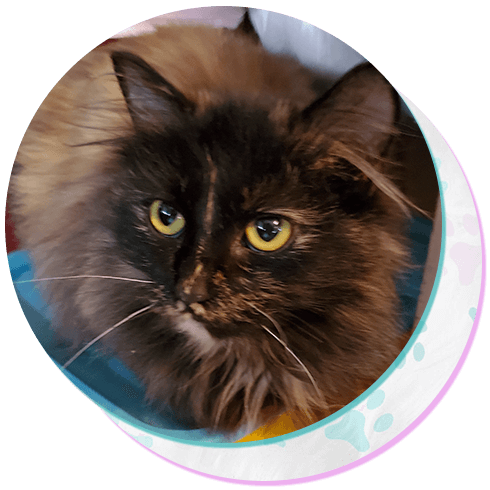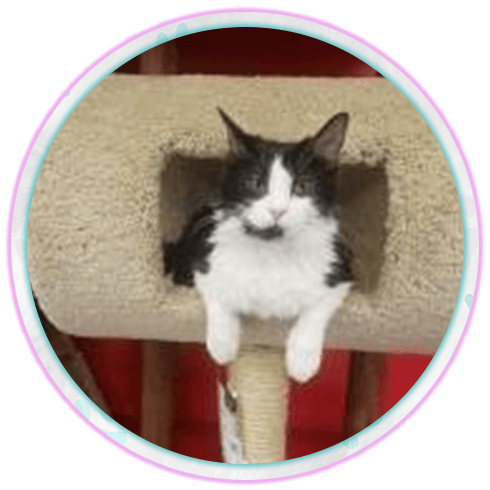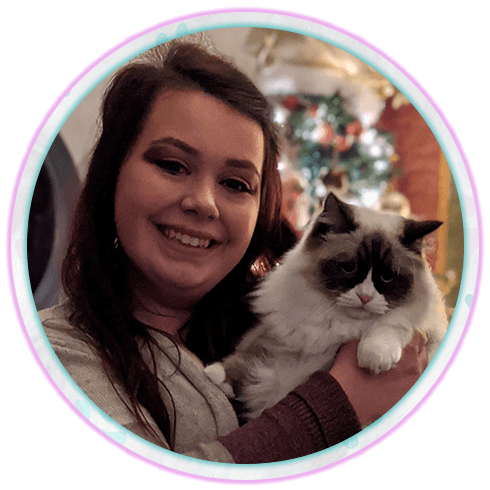About Tabby Town USA
Tabby Town is not a brick and mortar rescue with set hours of operation. (Not yet, anyway!) Tabby Town is a group of dedicated, loving volunteers who foster cats in their homes. The heart of Tabby Town is the residence of Marie Glover and her husband, Ted.
Tabby Town rescues orphaned kittens, special needs cats, abused, neglected and unwanted cats, and, as space permits, cats on death row from kill shelters.
All cats and kittens over 4 months of age are spayed or neutered prior to adoption. They receive age-appropriate vaccinations, are treated for parasites (worms, fleas, ear mites), and litter box trained. All of the cats and kittens have been tested for FIV (Feline Aids) and FeLV (Feline Leukemia).
Adopters of kittens younger than 4 months of age are given a voucher for the future spay/neuter/rabies at specified vet clinics.
Tabby Town does not euthanize cats or kittens just because they have Feline Aids or Leukemia unless they are extremely ill and already dying. We find homes for those felines and many of them live long, healthy lives. Our own WideLoad lived for 17 healthy years with FIV before succumbing. When we have “positive” cats for adoption, we provide information about the disease to potential adopters. We also make ourselves available for free consultations about any health issues that might arise for the rest of the cat’s life.
Our non-profit rescue depends solely upon contributions from caring cat lovers like you. We are not supported by any government or municipal entity. Our yearly expenses far outweigh what our modest adoption fees bring in. Your contributions are, of course, tax-deductible in accordance with the laws of the State of Wisconsin.
Tabby Town believes in cat behavioral training instead of declawing and asks that adopters NOT DECLAW their cats. You owe it to your cat to educate yourself on the subject. If a potential adopter insists on a declawed cat, we help find them a cat who is already declawed.

In The Beginning
Tabby Town was started by Marie Glover and her husband, Ted, of Westby, Wisconsin, in the fall of 2003. Their son was heading off to college and he wanted a kitten of his own, so the family visited the local dog pound. Although there were no kittens there at the time for Dennis, a young tortie caught their attention by reaching out through the bars of her stark cage, pleading for attention. Apparently she was taken to the facility after being hit by a car about six weeks prior to that, but hadn’t yet been seen by a vet. Within minutes, “Tripod” was in the family car heading to Westby to begin the rest of her life. Tripod’s leg could not be saved. She had permanent damage to her mouth and ear, and it took a year for her to heal. She became a life-long resident of Tabby Town and often times greeted visitors, always begging for treats ~ and she got them!
After the dog pound visit, Marie began volunteering there in an effort to make life easier for the cats. Back then the dog pound was a municipal-run facility and life for the cats there was a meager existence, oftentimes bitter cold, generally dark, very lonely, and ear-piercing from the constant barking of dogs.
It wasn’t long before Marie brought home weak kittens who would otherwise have died and highly stressed pregnant cats who more than likely would’ve prematurely aborted their babies. She found it utterly heart-wrenching to see so many wonderful cats caged for too many long hours day after day, week after week, month after month. She knew she had to do more for the homeless cats, so she talked with Ted and they decided to open their own cat rescue, albeit their home, where the cats would be safe, always warm and know the touch of kind hands. By the middle of 2004, Marie quit her job to manage the rescue full-time from her home, which is proudly called Tabby Town USA, Inc.

Tabby Town Opposes Declawing
After rescuing and living with almost 4,000 cats since 2004, we’ve had the opportunity to compare declawed cats to those with their claws, and we’ve come to some horrific conclusions about declawed cats. Please take time to read our personal experiences below. But don’t just take our word for it ~ We aren’t the only ones opposed to this cruel practice. Go ahead and check the internet to see what others say, and you’ll find tons of information about the detriments of declawing.
Declawing Facts
Declawing is irreversible
Declawing is 10 separate amputations
It is NOT simply “removing the toenails.” It’s like cutting off a person’s fingers at the knuckle closest to the fingernail. Look at your fingers right now. Go ahead and touch the tips. Feel the sensitivity. How would you deal with the pain and life-long after effects of having every one of them cut off? Talk to people who have lost part of a digit, or had any amputation. Ask them if they experience phantom pain. And listen to them.
Many declawed cats who get outside lose their lives to predators
Some people insist that their declawed cat will never get outside, but what happens when a visitor comes to the house, or a babysitter, or relatives during the holidays, and your kitty accidentally gets outside? Never having been outdoors before, he’s vulnerable to not only traffic, but birds of prey (hawks, owls, eagles) and carnivores (dogs, coyotes, fox). And what if your declawed kitty likes it outside? A friend of ours, Art, let his declawed kitty, Whiskers, outside quite often. It was not a big deal. Whiskers always stuck around. One day, just before dark, he was about to call his kitty indoors when an owl swooped down and scooped up the large black & white cat. That was years ago, and Art can still hear that cat’s screams as the owl flew away with his kitty. And we learned a terrible lesson with our declawed Oreo. She loved to sit on our deck in the sun. She never left the deck ~ never. But one sunny day, a neighbor’s dog came to the house and dragged her away, defenseless, from our deck. We found pieces of her fur in our back yard and the rest of the body in the neighbor’s dumpster. He admitted throwing the cat in there after he found her on his lawn. Oreo, from the bottom of our hearts, we’re so sorry…
Cats walk on their toes
Take Niko, for instance. When we found out that we were her 7th home, we decided that we’d just keep her instead of putting her through yet another adoption and disruption in her life. We had several years to look after her. Niko was declawed and well into her teens. She was very hunched over and couldn’t stand tall on all fours. Ever. She needed pain medication every day. Without pain meds, she could hardly walk to her food dish. She hadn’t been able to jump to the couch for months because she had lost the strength in her hind legs. Overall she was a healthy kitty, but the arthritis had taken its toll, and we saw the pain in her face every day.
Declawed cats tend to hide, hiss and bite without their claw defense
They know they’re helpless, so when they’re introduced to new cats, new people, or new situations, they’ll hiss or growl fiercely, bat and even bite to keep the newcomer away. Felicity actually screamed. She lunged at us teeth first for over five months before she allowed us near her. Five months! Even after that, she was seldom approachable and always on guard. We could never adopt her out because of her temperament and Felicity was with us for two years before she passed on. She never did totally let her guard down. Can you imagine living day after day, month after month in fear like that? Poor Felicity. May she rest in peace.
Cats scratch. It's what they do.
They don’t scratch just to “sharpen their claws” or to be obstinate. They scratch to mark their territory. If they cannot mark their territory with their claws, they may tend to spray ~ males and females! And once they start spraying to mark their territory, it’s next to impossible to break that habit if the cat is declawed. The number one reason people get rid of their cats is because of litter box issues. 9 out of 10 declawed cats that end up at the humane society are euthanized (killed) from problems caused by the declawing!
Most major countries have outlawed the declawing of cats
It is either illegal or considered extremely inhumane and performed only under extreme circumstances to declaw cats in the following countries: Australia, Austria, Belgium, Brazil, Denmark, England, Finland, France, Germany, Ireland, Italy, Japan, Netherlands, New Zealand, Northern Ireland, Norway, Portugal, Scotland, Slovenia, Sweden, Switzerland, Wales, and Yugoslavia.
Veterinarians in the United States make a ton of money declawing cats
How many of them explained the procedure to owners prior to the surgery? Even though it takes less than 10 minutes to cut off the toes, it is major surgery. They keep their cats overnight because they don’t want the owners around when their cat comes out of anesthesia. They don’t want them to hear their cat’s horrendous screams, see their cat bouncing off the sides of the cage in excruciating pain, or to see the blood seeping from the bandaged paws and dripping off the walls of the cage. We’ve seen it. We’ve heard it. You don’t want to.
Tabby Town opposes declawing, and with good reason
With the alternatives available today, there is no reason to EVER declaw a cat. To all of the kitties that came to Tabby Town with problems from declawing, we apologize on behalf of your previous owners. We hope that just one person understands what you’ve lived through, and will not declaw another cat.
How to Trim Your Cat’s Claws
Before you even start, make sure you and your kitty are calm and relaxed. Make sure there’s plenty of light and that you are both comfy. Talk softly to your kitty. ABOVE ALL, BE PATIENT!
- Put kitty on your lap. Support him securely in your left arm with his front paw in your left hand. Wrap him in a towel if it’s easier and if kitty tolerates it. Better yet, have a second person hold the kitty, by the scruff if necessary.
- Press gently but firmly on the pad area, under one toe, to extend a claw. Don’t squeeze hard.
- Look for the “quick” ~ the pink area in the center of the claw.
- Hold the clippers parallel to the flat part of the claw, not straight across like you’re trimming your own nails. Quickly snip off the tip, being careful not to cut into the quick. Try to angle the cut following the curvature of the claw.
- Talk softly to your kitty and tell him what a good kitty he is. Give him a treat for being such a nice cat.
- Stay relaxed and keep kitty calm. Repeat until all front claws are trimmed.
Trimming Tips
- Get kitty used to clipping by playing with his paws during petting time. He’ll think clipping is no big deal, really!
- Try clipping his claws while he’s sleeping.
- USE A SHARP NAIL CLIPPER! Otherwise, there’s a chance the claw will crack or split ~ OW!
- If kitty becomes anxious, STOP IMMEDIATELY! DO NOT SCOLD KITTY! Just do one claw a day if need be.
- Don’t forget to treat yourself for a job well done! (Chocolate works!)
Frequently Heard Comments From Potential Adopters
We’ve always had declawed cats and haven’t had any problems. No problems that you’re aware of. If you’ve never had a cat with claws, you may not know the huge difference between them. Many declawed cats hide, hiss or bite. Most people think that that’s normal behavior for cats, or that the cat is being independent. It isn’t. Oftentimes we hear that someone’s cat has “attitude.” Hmmmmmm…. And wait until the kitty ages. The painful signs of arthritis will be there!
He's going to be a totally inside kitty
We know you think so, and hopefully nobody else will accidentally let your kitty outside in the next 20 years either. Maybe a UPS driver or flower delivery person? Your kids´ friends? A holiday guest? A declawed cat outdoors is defenseless against predators, plain and simple. We get several calls a month from people looking for their declawed kitties who accidentally got outside and disappeared. Why would you take that chance with the kitty you love?
We don't want him scratching our furniture; we have a leather couch
We’d like to respond with, “well, what´s more important, your furniture or your cat,” but we don’t. We do know that people like to have nice furnishings and it can be quite expensive. So instead, here are some ideas on how to train your cat. First of all, when you bring a new kitty into your home, cover the furniture with a quilt or throw to protect it. (You can always remove it when you entertain.) Be sure to provide kitty with a proper scratching post or cat tree. It should be tall enough so kitty can stretch way up high on it when he’s full grown, to stretch his muscles. It must also be sturdy. If the post moves or topples over, he won’t want to use it again. Some cats prefer sisal rope to carpeting, so give him different surfaces to scratch. And believe it or not, some cats need to be shown how to use them. Rub catnip on the rope or carpeting, and actually take his paws in your hands and show him how to scratch.
In addition, you should give kitty some corrugated cardboard to sharpen his claws on. The most popular thing at Tabby Town is a circular toy with corrugated cardboard in the middle and a ball in the outer ring that cats can chase. Sprinkle a bit of catnip on the cardboard and watch kitty go crazy ~ it’s amazing! The toy runs about $20. Once your cat starts using cardboard, sisal rope or carpeted cat trees, he’ll prefer those to your furniture. But what if you have a really stubborn kitty who thinks the couch is his to use as he pleases? Just put the scratching post in front of the area he’s trying to use, so he has to use the post instead. Or try using “Sticky Paws” (about $10) which are furniture-safe strips of clear double-sided sticky plastic, so when kitty touches it, he’s discouraged by the stickiness on his paws. Another idea is to cover kitty’s claws with “Soft Claws.” They’re wonderful! They look like hollow claws, very blunt on the end, and they glue on over the top of kitty’s trimmed claws. Most cats tolerate them very well and you only need to put them on the front claws. They come in several different sizes and colors, and you get about 30-40 in a package for about $20.
Important: Be VERY CAREFUL using the glue. If you use too much and it leaks out of the vinyl cap, it will adhere the Soft Claw to the kitty’s toe pad. As the real claw grows, it will pull on the pad causing kitty much pain and he will limp. When the Soft Claw is removed, it will make the toe pad bleed.
We don't want him to scratch the kids
We’ve found that declawed cats tend to bite a whole lot more than cats with their claws. Without their first line of defense, declawed cats use their teeth. Sometimes kids are too young to handle cats, or don´t know when to leave kitty alone, so kitty will react the best way he knows how. Without his claws, he’ll bite. It’s very easy to trim claws, as shown below.
We don't want the cat to hurt our dog
All the more reason for kitty to keep his claws. A cat with his claws is much more liable to bond with a dog, and he really won’t scratch the dog once they’re friends.
Board of Directors

Gale Bruessel
Gale Bruessel serves as a Board of Director and Volunteer Coordinator. She coordinates the cat habitat at our adoption events location, Petco of Onalaska, and is a long-term foster home for Tabby Town. She is involved in our adoption days events and fundraising activities. She gets great satisfaction from intaking ill cats and kittens, helping them through the healing process, and then moving them on to their forever homes.

Heather Armstrong
Hi! I’m Heather Armstrong. I never knew I would be a cat person but here I am… totally in love with these smart, loving and beautiful creatures. I came to Tabby Town in 2016 after they helped me rescue, treat and rehome dozens of stray, feral cats that would come to my property to have kittens.
During that time, my husband kept finding cats while he was traveling for work. They were always sick. Tabby Town provided immediate, long term care… even facilitating surgery to spay and neuter them before they came to live with me.
Tabby Town’s passion and unconditional love for cats of all kinds is heartwarming. I am continually impressed with their knowledge and grateful they allowed me to be a part of their awesome organization.
Tabby Town is the best and continues to educate the public about cats, rescue and rehome some of the most hopeless cats and in my book, is changing the world one cat at a time.

Tracy Schultz
Hello! My name is Tracy Schultz. My boyfriend and I live in LaCrescent, MN with our 6 children. We love God’s creatures! We currently have dogs, cats and chickens.
I have been involved with Tabby Town USA since 2013 when my family adopted our first kitty. Since then, we have served as a foster home for hundreds more. Our home has become the go-to foster home for pregnant cats and young kittens.
My favorite thing about being a part of Tabby Town is seeing the joy of a family getting a new furry member. It is so heartwarming to see each kitty getting a second chance after being rescued from a rough start.

Kathy Eggen
I’m Kathy Eggen and I live in La Crosse with my 2 foster fails, Sissy and Maggie. Tabby Town adopted a kitty to me in 2005 and I began volunteering shortly after. My position on the Board of Directors is secretary. I have been cooking at Bethany Riverside since 1983. In my free time, I enjoy spending as much time as possible with my grandchildren.

Emily
Hello, I’m Emily! I’ve been on the Board of Directors since December 2017.
I developed a passion and love for animals at an early age. I used my “doll” blankets to make beds for my cat, Whiskers, growing up. I currently have cats and horses, but hope to add a dog, goats, ducks and chickens in the future.
Before Tabby Town, I spayed and neutered barn cats as soon as possible to prevent unwanted litters from being born. I have always been saddened by the fact that kittens are born into a world where there are not enough homes for them. Spaying and neutering has been a passion of mine, and ultimately led me to my involvement with Tabby Town.
I’ve fostered kittens through Tabby Town, but it’s hard for me because I want to love and keep all of them. In the future, my plan is to organize fundraising events so more cats can be spayed and neutered.

Grace Hoch
My name is Grace Hoch. I live in Winona, MN with my boyfriend and our two cats, Flynn and Ryder! I joined Tabby Town back in 2017 and have loved every minute of it. I fostered for two years, did many adoptions, and am now on the Board of Directors. My involvement with Tabby Town is now mostly helping with adoptions and Petco adoption days, but hopefully in the future I will go back to fostering! My favorite part about Tabby Town is finding the perfect home for every cat that comes through our care!

Marie Glover
Hi, I’m Marie Glover, the Founder, Executive Director and “Mayor” of Tabby Town. I take pride in everything I do for the cats. I live in our country home near Westby with my husband and have 3 grown children, 2 grandchildren and a step-granddaughter with my great-grandson! I share my love of cats with managing a thrift booth and painting furniture to sell at Sweet Valley Artisans in Coon Valley to raise money for the care of cats. Cats have been part of my life for as far back as I can remember (a long time!) and I still marvel at these glorious creatures!
I can’t imagine my life without cats. It’s so rewarding to watch a scared, shivering cat come to Tabby Town, grow stronger every day until he “comes into his own” and then find his furever home. There truly is nothing like it.
